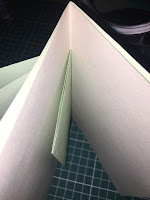I tried out the binding technique with normal coloured cartridge and sugar paper as it's only an initial idea/experiment that I had in my head, I thought I'd test it on normal cheap paper stock first. I create a few signatured pages to see how it will look with multiple pages in it as I've thought of having lots of pages in my publication - thought I don't know how many yet. I've also made the pages the penguin book size as this is the book size I am intending my publication to be in. Upon creating the experiment, I've realised that it is a bit complex and harder than it looks. Measuring how big the paper that will hold the pages together was a bit tricky because it needed to be loose enough for the pages to not get stuck but at the same time it can't be too tight or else it will rip the pages and unable them to fit in the spine. In addition, as I added the pages in the publication I noticed that a creep was starting to form in it, which I didn't really think would happen as I thought it would just fit on. But, thinking back at it now, the creep does make sense as the pages sit on top of each other much like a saddle stitch bind, therefore it will be impossible for me to add as much pages as I want and I will still need to separates sections of pages, which defeats the purpose of my aims in the first place. After, seeing this, I'm deciding to not use this binding technique for my publication as the paper stock/weight that I'm intending to use will be heavier that what I have tested on, which will be worse that my experimentations anyways. I am aware that certain options can be made in order to resolve the creep problem, such as adjusting the margins and bleed on the InDesign document, however on the other hand the amount of pages for my publication is a bigger concern for me at the moment and it is quite impossible for me to have at least 32 pages without having to section the pages as it's similar to a saddle stitch and I am aware that you can only use 8 pages maximum before a creep starts to form.
Thoughts & Reflections:
Initially, I thought that this binding technique would look very good and work effectively work for my publication without any problem as it looked pretty simple from the physical examples that I've seen from the G.F Smith talk. However, as I've started to apply the requirements that I had laid out for my own publication I immediately ran into lots of problems with it which made me think twice about using this technique. I think overall, if I was to weigh out the advantages and disadvantages of this binding technique it's clear than the disadvantages outweigh the positives, therefore it is futile of me to use this technique for my publication as it would fail to effectively communicate my concept. Furthermore, now that I think about it the examples I saw only had a few pages which made it look good and worked as a publication itself. Maybe if I was to create a less heavier publication this technique would've been appropriate and dynamic however for my current brief and idea it is very much ineffective and inappropriate.






No comments:
Post a Comment